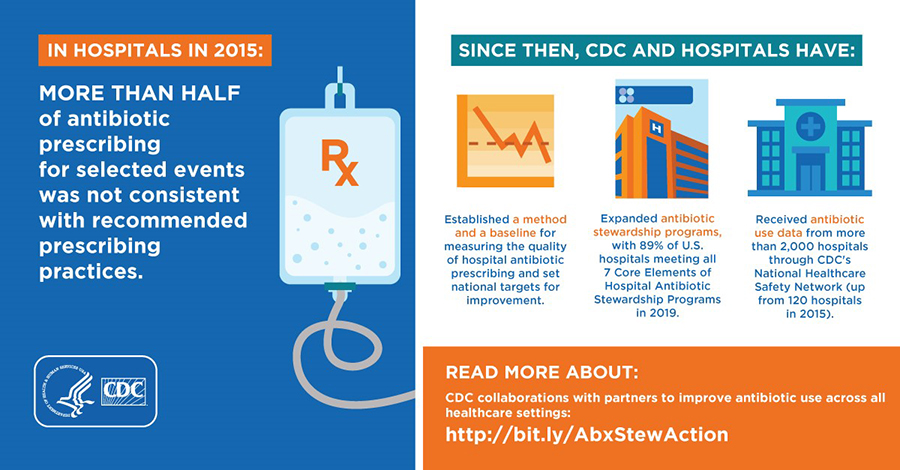New Study Sets Baseline to Measure Quality of Antibiotic Prescribing in U.S. Hospitals
Posted on by
Experts set national targets to improve prescribing—essential to protecting patients and slowing the rise of antibiotic resistance
On March 18, the Centers for Disease Control and Prevention (CDC) published a new study in JAMA Network Open showing that in 2015, more than half of antibiotics prescribed in U.S hospitals did not follow recommended prescribing practices. On the same day, The Pew Charitable Trusts announced the first-ever national targets to reduce inappropriate antibiotic prescribing in U.S. hospitals. The targets were established based on CDC’s study, with input from CDC and a panel of infectious disease and public health experts from around the country to better assess improvements in prescribing that have taken place since 2015.
The CDC study was one of the largest assessments of the appropriateness of antibiotic prescribing in hospitals to date. These data establish a method and baseline to help measure the impact of antibiotic stewardship programs going forward. The study examined four major categories of prescribing that account for the most common antibiotic uses in the United States, including treatments for two types of common infections (community-acquired pneumonia, or CAP, and urinary tract infection, or UTI) and two types of antibiotics (fluoroquinolones and IV vancomycin). The study found that unsupported antibiotic use was occurring in each of the four categories of prescribing in 2015, and that collectively nearly 56% of prescriptions evaluated at the 192 hospitals in the study were not consistent with recommended prescribing practices.
The panel of experts convened by Pew used current medical guidelines and best practices for treating each diagnosis to determine that hospitals should reduce unsupported prescribing when treating CAP and UTI by 90%, and reduce unsupported prescribing of fluoroquinolones and IV vancomycin by 95%.
Antibiotic stewardship programs are critical to ensuring appropriate use of antibiotics in hospitals. Since 2015, when the prescribing data were collected, CDC has been working diligently with partners like the American Hospital Association and others to implement stewardship efforts and programs in acute care.
- In 2019, about 89% of U.S. hospitals met CDC’s Core Elements of Antibiotic Stewardship.
- CDC now receives antimicrobial use (AU) data from more than 2,000 hospitals through the National Healthcare Safety Network (NHSN) AU Option, up from 150 hospitals in 2015.
CDC will continue building on this progress and important work in the coming years as a part of the newly released Combating Antibiotic-Resistant Bacteria National Action Plan.

Stronger Antibiotic Stewardship Programs Are Critical to Improve Prescribing
Inappropriate antibiotic use should always be minimized, because—as with any medication—antibiotics carry certain risks. All antibiotic use contributes to antibiotic resistance. Improving antibiotic use is even more important now as the pandemic continues and many U.S. patients hospitalized with COVID-19 receive antibiotics—many of which, as suggested by a recent report conducted by the team at Pew, might be prescribed inappropriately.
The panel’s recommended targets are ambitious, but they are achievable if partners commit to bolstering standards and strengthening implementation of hospital antibiotic stewardship programs. These programs—which are required for most hospitals by regulatory and accreditation organizations—aim to ensure that antibiotics are prescribed only for known or suspected bacterial infections, and that the right antibiotic is prescribed at the appropriate dose and duration of therapy.
Here are three key ways to meet targets for improving antibiotic use through antibiotic stewardship programs:
- Antibiotic stewardship partners, including regulatory and accrediting organizations, should ensure that all hospitals have effective, high-quality antibiotic stewardship programs. Public agencies and nongovernmental organizations that oversee quality of care should enhance policies that require and establish specific standards for stewardship activities, with an emphasis on reducing inappropriate use for the two infections and antibiotic types we assessed in our analysis.
- More hospitals should report into the CDC’s NHSN Antimicrobial Use Option. By monitoring antibiotic use, and reporting it into NHSN, hospitals with antibiotic stewardship programs will be able to compare antibiotic use in their facilities with other hospitals and detect areas where interventions are needed to improve prescribing. This monitoring and reporting would also allow public health agencies to assess prescribing at the national, state, and local levels, which would, in turn, help in the development of tailored reduction strategies, technical assistance for hospital stewardship programs, and the measurement of progress toward reduction targets.
- State and local health agencies, health systems, and quality improvement organizations should provide technical support to healthcare facilities, particularly small and critical access hospitals, to improve antibiotic stewardship program implementation. This step is especially important given that the COVID-19 pandemic may be disrupting antibiotic stewardship programs in some hospitals—with healthcare staff and resources shifted to meet urgent demands.
There is still substantial work to do to improve antibiotic prescribing, but by embracing the above actions, we can make significant progress toward the national targets we’ve set, help preserve the effectiveness of existing drugs, and better protect patients.
David Hyun, M.D., directs The Pew Charitable Trusts’ antibiotic resistance project. Melinda Neuhauser, PharmD, is the pharmacist and acute care lead for the CDC Office of Antibiotic Stewardship.
Posted on by

